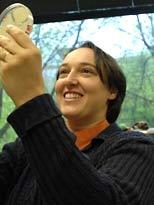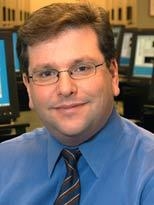MIT Professor Angelika Amon and Todd R. Golub of the Broad Institute of MIT and Harvard will share the 2007 Paul Marks Prize for Cancer Research, an award of $150,000, with Gregory J. Hannon from Cold Spring Harbor Laboratory.
The prize, from the Memorial Sloan-Kettering Cancer Center (MSKCC), recognizes significant contributions to the basic understanding and treatment of cancer by scientists no more than 45 years old at the time they are nominated.
Amon was cited for her work in studying how chromosomes segregate during cell division, while Golub was cited for developing genomic approaches to better classify subtypes of cancer. Hannon won for using model systems to study the biochemistry and biology of the RNA interference mechanism.
A current focus of Amon's laboratory is studying the effects of aneuploidy on the way that cells proliferate. Aneuploidy, in which a cell has an abnormal number of chromosomes, occurs if chromosomes do not separate properly. "Our recent work has dealt with the question of how aneuploidy affects the yeast cell's physiology," explained Amon, a professor of biology at MIT, member of the MIT Center for Cancer Research (CCR) and a Howard Hughes Medical Institute (HHMI) investigator. "We are now eager to investigate how aneuploidy affects mammalian cells."
"There is no doubt that Angelika Amon is a true star in basic cancer research," said Tyler E. Jacks, director of the CCR, a professor of biology at the Institute, and an HHMI investigator. "Her work has had a deep and lasting impact on our understanding of mechanisms crucial to proper cell division, which has helped to shape our insight into how defects in these processes contribute to cancer and other disorders."
Golub's group has made important discoveries on the molecular basis of several types of leukemia, some of which have resulted in genetic tests that are now standard at most major medical centers worldwide. His team was among the first to use microarrays (also known as DNA chips) for the classification of cancer. "The goal of our work is to develop a new molecular taxonomy of cancer," said Golub, an HHMI investigator who is also affiliated with the Dana-Farber Cancer Institute. "It is not enough to say someone has breast cancer or lung cancer, for example. There is a real need to subclassify patients, so that we can match patients very closely with targeted drugs and conduct smarter clinical trials."
"Todd Golub has made important contributions--both conceptual and technical--that have had wide-ranging impact on cancer research," said Eric Lander, founding director of the Broad Institute and a professor of biology at MIT. "In my opinion, he is one of the most creative and accomplished cancer scientists of his generation."
MSKCC President Harold Varmus described the winners as leaders in their respective fields. He said the scientists had made major contributions to the biological understanding of cancer, shedding light on what causes cancer and offering promising solutions that may someday provide benefits to patients everywhere.
Jacks shared the Marks Prize in 2005 for his work in advancing the understanding of the pathogenesis of cancer.
A version of this article appeared in MIT Tech Talk on October 3, 2007 (download PDF).







